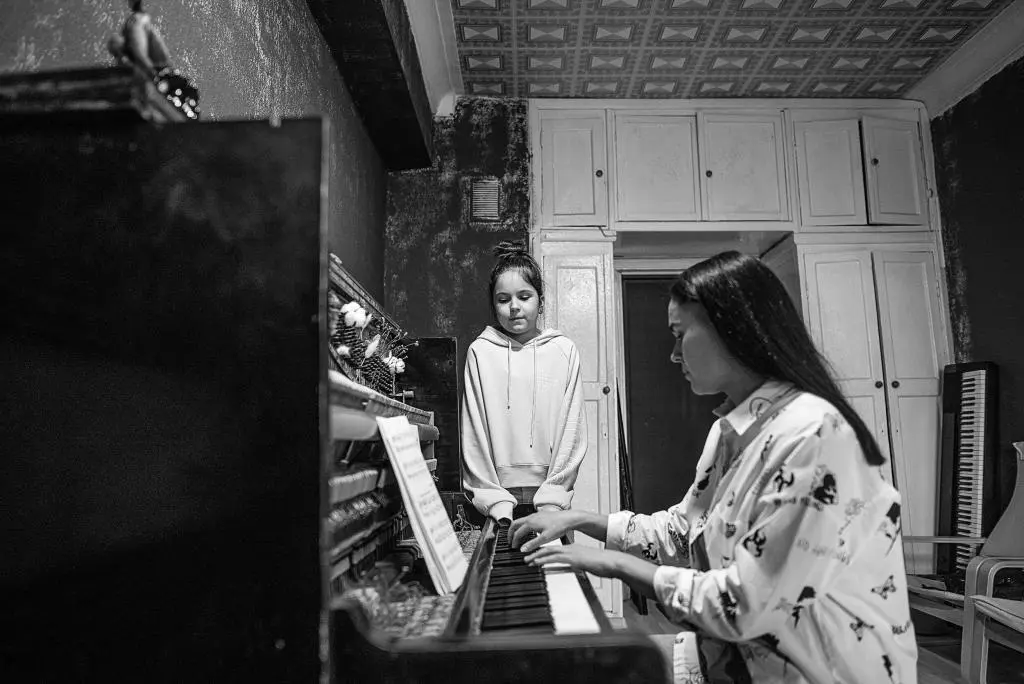Perfect pitch refers to the rare ability to identify or recreate a musical note without any reference. If someone with perfect pitch hears a C note played, they can instantly recognize and name the note as C, without needing to compare it to any other pitch.
This extraordinary talent is invaluable yet incredibly uncommon, estimated to be present in only 1 out of every 10,000 people. But for those gifted with perfect pitch, music is perceived on a whole different level.

Notes are imprinted in their minds with precision and clarity, almost like having perfect color vision while most see only in hues. This allows perfect pitch possessors to discern subtle variations in pitch that are impossible for most to detect.
What is Perfect Pitch: Table of Contents
For musicians, perfect pitch enables the capacity to recreate melodies purely from imagination, without external musical cues. It’s a profound advantage, though some argue that relative pitch is more useful in real-world musical applications.
Either way, the phenomena of perfect pitch has captivated the curiosity of musicians, scientists and music enthusiasts alike for centuries. Only in recent decades have researchers begun unraveling the complex interplay between genetics, neurobiology and learning that give rise to this marvelous musical ability.
The mystique surrounding perfect pitch serves as a microcosm for the larger relationship between innate talent and cultivated skill. While advantages are undoubtedly conferred by natural aptitude, emerging science shows even those not blessed at birth can develop impressive musical abilities through passion and diligent practice.
Defining Perfect Pitch
At its core, perfect pitch represents the extraordinary capacity to recognize and identify musical notes without any reference or context. Someone with true perfect pitch can hear a single piano key struck, and instantaneously name the precise note being played, whether it’s a D, F sharp, or any other tone on the musical scale.
This is an ability most musicians can only dream of possessing. For anyone else, identifying a note in isolation would be virtually impossible. We depend on relational context, requiring a starting reference pitch to deduce other notes relative to it.
That’s why perfect pitch is often viewed as an almost superhuman musical power. Those blessed with it literally have a mental catalog of every potential pitch engrained inherently in their mind.
In fact, experts delineate between two types of perfect pitch: active and passive. Individuals with active perfect pitch can summon notes from thin air – if asked to sing an E-flat without accompaniment, they can produce the precise tone without hesitation.
Those with passive perfect pitch lack the vocal precision to conjure notes at will, but can correctly identify any note they hear. Both types represent rare musical fluency found in a only tiny fraction of the population.
Perfect Pitch vs Relative Pitch
Relative pitch, while less glamorous than perfect pitch, is the more functional musical skill. With relative pitch, notes are recognized in relation to an initial reference note. After hearing a starting pitch, musicians with strong relative pitch can reliably identify other notes by their distance in scale degrees.
This allows for practical abilities like identifying if a singer is out-of-tune, transposing a song into a new key, and navigating chord structures by ear – musical superpowers in their own right.
For real-world musicianship, relative pitch is a lifesaver while perfect pitch is more of a party trick. The ability to label notes in isolation, without context, has limited concrete applications. Meanwhile, the relational perception of relative pitch forms the core of playing by ear, arranging harmonies, and detecting discordant notes.
That said, links likely exist between the two. Individuals with perfect pitch may have honed robust neural foundations for discerning notes, which could theoretically facilitate relative pitch skills. But the reverse is unlikely – gaining flawless pitch memory simply through expert relative skills is improbable based on current evidence.

Prevalence and Origins
Perfect pitch is undeniably an anomalous gift. But precisely how unusual is this ability?
Overall estimates suggest only about 1 in 10,000 people have genuine perfect pitch. However, incidence seems significantly higher among musicians – somewhere between 1 in 10 and 1 in 100 are believed to possess it, though estimates vary.
Accumulating research hints that perfect pitch may be more prevalent than previously thought. A 2021 study analyzing over 30,000 participants found a perfect pitch rate of 1 in 600 – far exceeding traditional estimates.
Additionally, levels of precision vary – some possess flawless note recognition abilities, while others demonstrate only rudimentary levels of pitch identification. The boundaries of what constitutes true “perfect” pitch remain nebulous.
Ultimately, there seems to be a “pitch perception spectrum”, with exceptionally few anchoring the most perfect end. But many may experience glimmers of natural pitch affinity falling short of perfection. Where precisely to draw the line is debatable.
Is Perfect Pitch Genetic?
Intriguingly, perfect pitch exhibits strong familial links, indicating possible genetic underpinnings. Surveys reveal an estimated 30-50% of individuals possessing perfect pitch have a relative with the talent.
This hereditary connection accords with examinations revealing distinctions in brain structure and functionality between those with and without perfect pitch. Certain cortical regions linked to pitch processing appear enhanced in perfect pitch musicians.
But nature alone cannot fully explain perfect pitch manifestation. Nurture, in the form of early exposure and training, also plays a substantive role. Pitch recognition requires meaningful, intentional cultivation to fully blossom into perfect form.
In reality, there is no singular “perfect pitch gene.” Rather, a complex interplay likely exists between genetic predispositions and aspects of early auditory development. This delicate fusion primes select individuals to attain heights of pitch perception precious few can mount.
Cultural and Linguistic Influences
A wider cultural spotlight shines on perfect pitch in East Asia, where it is more revered and actively fostered. This traces to possible connections with tonal languages like Mandarin, in which pitch distinguishes word meaning.
Studies reveal children fluent in tonal languages are substantially more likely to develop perfect pitch, perhaps reflecting heightened neural circuitry for pitch processing. These languages may tune the auditory system from an early age to discern finer pitch details.
But while language and culture shape perfect pitch incidence, they alone cannot fully explain its rarity worldwide. After all, musicians in non-tonal language communities still cherish and value highly refined pitch perception.
Ultimately, a mesh of biological proclivities, cognitive potentials, and experiential exposures underpins the blossoming of perfect pitch. This rare gift sprouts only for the exceptional few situated at the perfect intersection of nature, nurture and dedicated cultivation.

Recognizing and Testing for Perfect Pitch
Certain cues signify the potential presence of perfect pitch. Individuals exhibiting natural proficiency at tasks like:
- Identifying isolated musical notes without referring to a reference pitch
- Accurately singing or playing specific notes when prompted, without trial and error
- Detecting when music is out of tune, even if the deviation is subtle
- Remembering and reproducing melodies after only brief exposure
may possess traces of perfect pitch perception. While skills like these arise from other musical gifts as well, they warrant further perfect pitch screening.
Interestingly, even those lacking formal music training altogether can demonstrate nuanced pitch perception resembling imperfect or quasi-perfect pitch. For example, quickly noticing when familiar songs are played slightly out of key, or exhibiting above-average ability to recognize wrong notes in isolated musical tones.
Methods for Testing Perfect Pitch
Scientifically assessing perfect pitch requires specialized tools for generating individual test tones, and measuring speed and accuracy in pitch identification across wide-ranging frequencies.
But a basic sense of pitch identification ability can be gleaned through simple do-it-yourself musical tests:
- Have the test subject attempt to name notes played individually on a piano, without providing a reference pitch first. Even approximating the octave demonstrates latent pitch skills.
- Similarly, test their ability to accurately sing specific target notes prompted verbally, like asking them to vocalize an E or G sharp without instrumental accompaniment.
- Assess if they can notice subtle detuning of familiar songs by playing pitch-shifted versions and observing if they detect a difference from the original.
While in no way foolproof, these basic exercises offer a taste of distinguishing various dimensions of pitch perception – shedding light on the enigmatic, finely-tuned musical gift of perfect pitch.
Famous Musicians with Perfect Pitch
Perfect pitch has been documented and observed in acclaimed composers and musicians across history. While verification is often impossible for historical figures, strong anecdotal evidence exists pointing to extraordinary pitch perception abilities.
Ludwig van Beethoven was reported to possess exceptionally refined pitch discernment. Contemporaries described him as capable of fully grasping intricate multi-part music simply by looking at the score, thanks to his acute pitch recognition abilities. He could hear the complex interweaving lines clearly in his mind.
Wolfgang Amadeus Mozart demonstrated prodigious musical talents from early childhood, including exceptional pitch identification that struck observers as wondrous. Historical accounts depict him flawlessly naming notes across a wide register when played randomly on keyboard instruments. He could also transcribe lengthy and elaborate compositions nearly perfectly after just a single hearing, thanks to his acute sense of pitch relationships.
Other prominent composers like Frédéric Chopin, George Frideric Handel, and Claude Debussy exhibited potential traces of perfect pitch in their musical works and rehearsal habits. However, substantiating such claims is challenging without recorded evidence. Definitions of perfect pitch also varied widely in eras predating modern psychology and neuroscience.
Jimi Hendrix stands out among more recent musical icons believed to have possessed perfect pitch abilities. Accounts from fellow musicians detail his extraordinary capacity to analyze and replicate complex guitar parts and solos after minimal exposures. Engineering session tapes document his frustration when instrument tunings deviated even slightly from standard pitches.
Many jazz greats including Ella Fitzgerald, Miles Davis, and Art Tatum exhibited signs of perfect pitch, enabling their creative collaborations and improvisations. Frank Sinatra and Nat King Cole also leveraged superb pitch accuracy in their captivating vocal phrasing and delivery.
Contemporary Artists
In the modern era, perfect pitch has been associated with and verified in various pop music stars through interviews, scientific research, and musical performances. Contemporary artists who have demonstrated extraordinary pitch perception include:
Mariah Carey possesses a legendary vocal range spanning over 5 octaves combined with perfect pitch ability she has described as an involuntary gift since childhood. She recounts randomly hearing mundane noises and instantly identifying their precise pitches. Her pitch accuracy has been demonstrated across her extensive repertoire.
Michael Jackson showed signs of perfect pitch through his live performance precision and intricate multi-track studio recordings. Engineers noted his displeasure if instruments or tracks were even marginally out of tune. His vocal mastery revealed nuanced pitch control.
Ed Sheeran exhibits hints of perfect pitch in his intuitive guitar playing and singing. He can seamlessly switch between fluctuating tunings and modulate keys effortlessly in live shows, suggesting a strong internal pitch reference.
Stevie Wonder was blinded at birth but developed mastery over pitch recognition and production from a young age. His textured vocal layering and harmonies reflect precision only possible with highly refined pitch ability.
Ariana Grande possesses a wide vocal range comparable to Mariah Carey’s along with perfect pitch ability enabling flawless live vocals and runs. She can recreate complex arrangements and riffs with precision after minimal exposures.
Charlie Puth stands out for openly embracing his perfect pitch, even showing how he can name notes from everyday sounds. But Puth emphasizes that while helpful, the ability must combine with creativity and work ethic to make groundbreaking music.
The Science of Perfect Pitch
At its core, perfect pitch represents an extraordinary convergence of nature and nurture. Scientific investigation has uncovered key insights into the neurological architecture and developmental origins underpinning this rare gift.
Neurological Insights
Techniques like fMRI brain scanning have revealed structural and functional enhancements in the auditory cortices of musicians with perfect pitch.
Specifically, the right auditory cortex contains greater volume of gray matter – suggesting expanded neuronal resources dedicated to sound and pitch processing. Activity in this region is also more robust and coordinated.
Additionally, strengthened connectivity between auditory regions and certain frontal lobe zones points to more efficient audio-motor integration – critical for translating pitch perceptions into vocal reproduction or instrumental performance.
In summary, those gifted with perfect pitch literally possess enhanced neural circuitry for every stage of pitch processing, from sensory input to cognitive labeling and motor output.
The Autism Connection
A curious link has emerged between perfect pitch and autism, with disproportionately high levels of perfect pitch documented among those on the autism spectrum.
This suggests certain shared neurological traits, like hyperconnected local neural networks alongside reduced long-range connectivity. In autism, this manifests as increased focus on details alongside difficulty with bigger picture integration.
Likewise in perfect pitch, intricate local neuronal connectivity within auditory brain areas may enable exquisite pitch detail detection, while broader connectivity shortcomings could underlie real-world musical challenges.
More speculatively, overlap in genetic expression profiles related to neurodevelopment could also play a role. The interplay likely involves multiple factors, but the correspondence provides vital clues into the elusive cognitive architecture giving rise to perfect pitch.
Unpacking the perfect pitch-autism link may unlock improved understanding of auditory neurobiology on a wider scale. This knowledge could ultimately help demystify our diverse perceptual experiences of music.
Acquiring Perfect Pitch
The origins of perfect pitch have been intensely debated, with traditional views arguing its development depends on musical immersion within a “critical period” in early childhood. But fresh nuance has recently emerged around the teachability of this rare talent.
Critical Period in Childhood
For decades, researchers believed perfect pitch could only be acquired during an age-delimited window of heightened neuroplasticity, around ages 3-6 years old. Exposure to music and pitch patterns during this period was thought to be crucial.
Accordingly, perfect pitch was considered impossible to teach later in life due to declining brain malleability. But refinements to this “critical period” concept reveal pitch pattern recognition can strengthen well into adolescence and adulthood under optimized training conditions.
In particular, pairing pitch training with techniques promoting neuroplasticity – like non-invasive brain stimulation or engaging in aerobic exercise prior to practice – may expand the retention of pitch information in auditory areas.
So while early childhood remains prime time, the window for benefiting from musical pitch exposure appears wider than previously thought.
Training and Learning
A pivotal study found that some non-musicians could significantly improve their pitch recognition accuracy through just brief software-based training, demonstrating adult pitch pattern learning capacity.
Other research identified an EEG brain response strongly predictive of pitch identification ability, hinting at trainable markers of perceptual musicality.
Together, these insights suggest that while elusive, perfect pitch may not be utterly inaccessible to aspiring musicians without early music exposure. Targeted regimens could promote latent skills, especially if informed by neuroscientific knowledge of optimal plasticity conditions.
For instance, coupling ear training exercises with activities like foreign language learning may synergistically strengthen pitch memory through overlapping neural circuit development.
Implications for Musicians
For the few musicians gifted with perfect pitch, this ability offers both creative assets and potential challenges. Perfect pitch interweaves advantages and obstacles across composition, performance, and even simply listening to music.
Advantages in Music Production
Perfect pitch can facilitate inventing and remembering original melodies, as notes are directly accessible without reference. Composing harmonies can also benefit from intuitively grasping compatible pitches.
During performances, perfect pitch enables rapid identification of tuning issues. Vocalists or instrumentalists can adjust intonation precisely upon hearing clashing notes, without trial and error.
Production-wise, those with perfect pitch may excel at picking out flawed intonation in multi-track recordings. They also likely possess an inherent general sense for which chords and melodic patterns “sound right” together through extensive exposure.
Potential Challenges
Perfect pitch can make transposing pieces into new keys uniquely challenging. Music in altered keys might sound “wrong” to someone whose internal sense of pitch relations became wired to the original key.
Relatedly, adopting to new concert tuning standards like A=440 Hz can prove difficult since deviations from their engrained absolute pitch references are easily noticed.
Even experiencing music solely for emotional enjoyment may be impacted. Appreciating a piece may be undermined by over-attention to “wrong” notes, as opposed to getting lost in the expressive bigger picture.
However, the trade-off for most musicians seems well worth it. As music psychologist Philip Ball notes, while potential tuning quirks arise: “you can always base your [sense of] ‘rightness’ on a fixed anchoring pitch.” The creative benefits outweigh difficulties.
Relative Pitch as an Alternative
While only an elite few possess genuine perfect pitch, the more attainable skill of relative pitch offers valuable musical benefits. Relative pitch provides a flexible and practical alternative for discerning pitch relationships.
Characteristics of Relative Pitch
With relative pitch, notes are identified in relation to an initial reference pitch, rather than recognized absolutely. After hearing a reference, those with strong relative pitch can pinpoint other notes in terms of their interval distance from the first.
For example, upon hearing a starting C note, someone with solid relative pitch could then identify an E note as the major third above C. This relational perception is learnable for many.
Research suggests anywhere from 1/3 to 2/3 of trained musicians have functional relative pitch. And even everyday listeners can improve pitch processing through ear training. Genetics likely plays some role, but nurture is paramount.
Cultivating Relative Pitch
Many effective exercises exist for honing relative pitch. Interval recognition drills help internalize the distance between common pitch pairs. Interval singing ascending and descending through scales cements relationships.
Associating memorable song excerpts with particular key pitches can serve as cognitive anchors. For instance, remembering the opening phrase of “Here Comes the Bride” starts on C can provide a reference point for the C major scale.
Transcribing melodies and basslines by ear trains intuitive perception of how pitches relate in musical contexts. Focusing on the size and contour of intervals rather than pitch names can bypass cognitive limitations.
With dedication, strong relative pitch ability is attainable for most people. Though the brilliance of perfect pitch remains elusive to many, excellence in musicianship ultimately depends more on mastering creativity and technique – skills within reach for all sufficiently inspired.
Final Thoughts
The rare gift of perfect pitch has captivated musicians, scientists and curious minds for generations. This singular talent tantalizes with its hints of inborn musical brilliance lurking within a select few.
Yet as research progresses, perfect pitch reveals itself not as mystical endowment, but rather a nuanced interplay between nature and nurture. Genetic predispositions may confer advantages, but intentional environmental exposure and training proves vital for engraining the neural circuitry underlying pitch identification.
While relatively rare, perfect pitch exists on a spectrum with select individuals anchoring the pinnacle. With focused cultivation, glimmers of pitch discernment remain attainable. Though the purity of true perfect pitch may remain elusive,lookup−song related abilities like robust relative pitch offer valuable musicianship tools.
Ultimately, the exact parameters defining perfect pitch matter less than channeling one’s unique proclivities creatively. Even lacking innate gifts, passion and persistence unlock lasting musical excellence. The intersection of talent and determination writes stories of greatness.
So while perfect pitch showcases the extraordinary possibilities of human potential, it remains merely one manifestation of our diverse musical capacities. With openness, curiosity and dedication, harmonious beauty lives within reach of all. Wherever our talents rest, the joys of music and discovery await.

